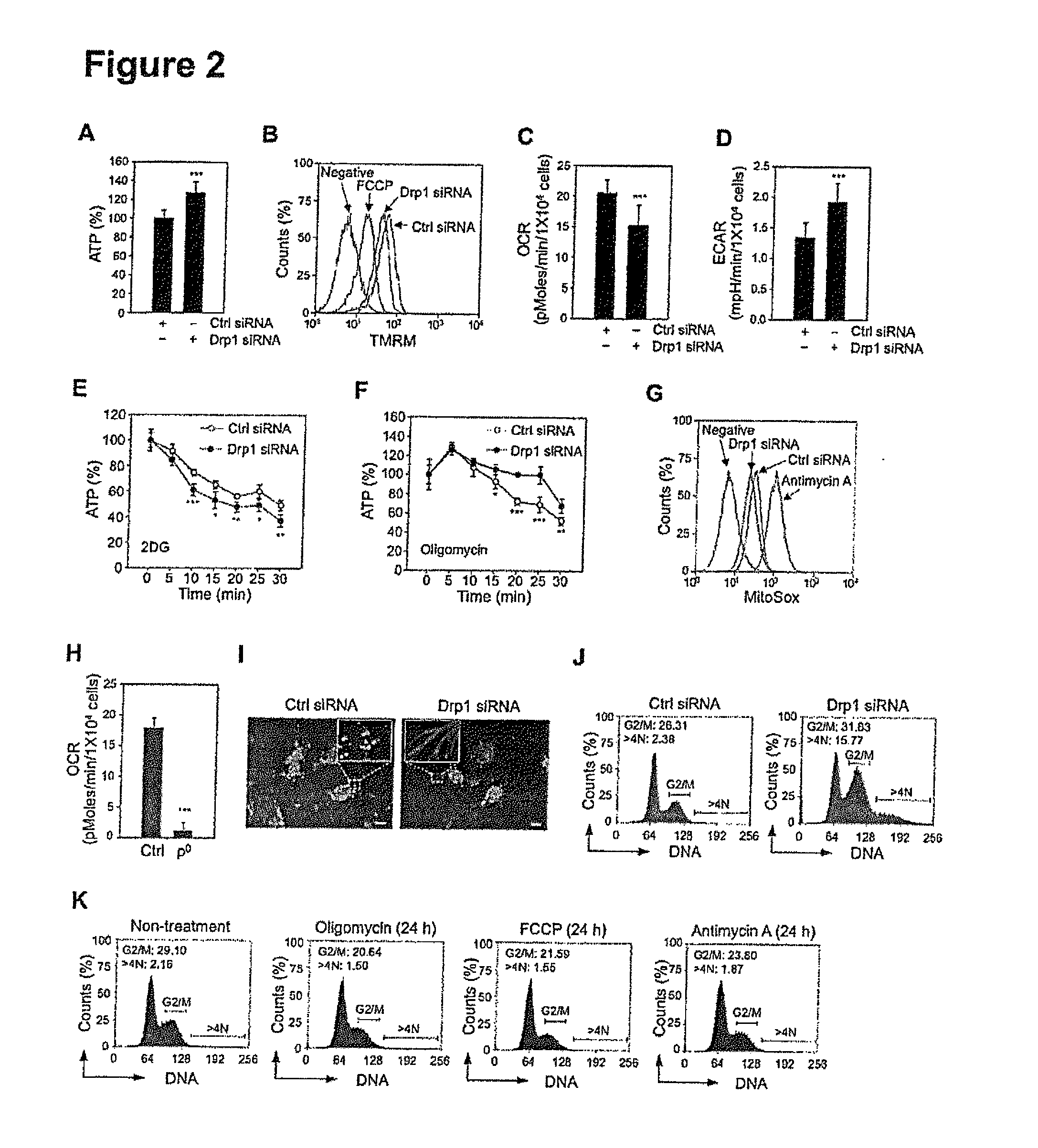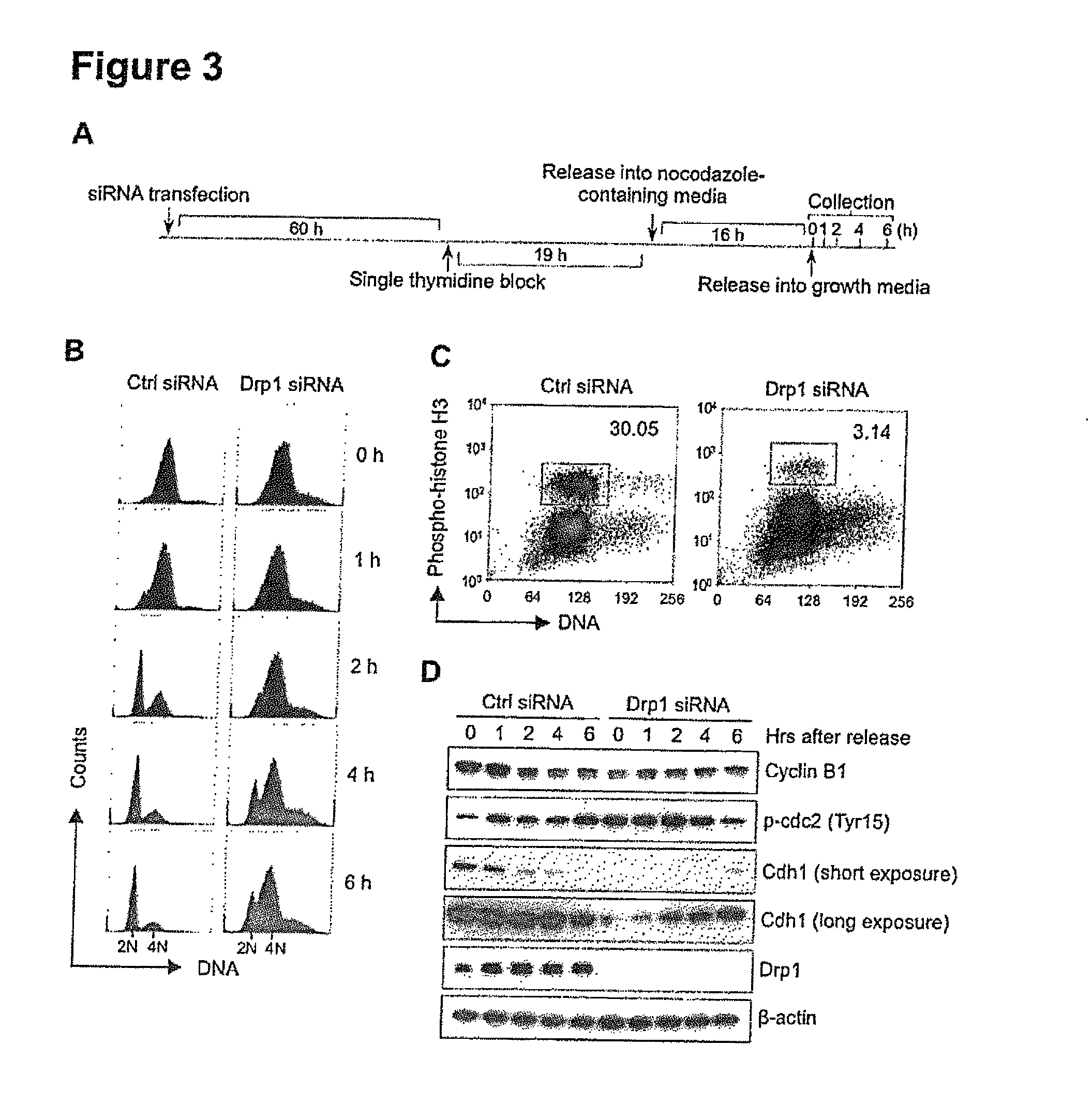Inhibition of dynamin related protein 1 to promote cell death
- Summary
- Abstract
- Description
- Claims
- Application Information
AI Technical Summary
Benefits of technology
Problems solved by technology
Method used
Image
Examples
example 1
6. EXAMPLE 1
Mitochondrial Hyperfusion-Induced Loss of Fission Protein Drp1 Causes ATM-Dependent G2 / M Arrest and Aneuploidy Through DNA Replication Stress
6.1 Materials and Methods
[0071]Cell Culture and Transfection.
[0072]The human breast carcinoma cell lines MDA-MB-231, MCF7 and MDA-MB-157, and the human lung carcinoma cell line A549 and H1299 were obtained from American Type Culture Collection (ATCC). Cells were cultured in RPMI 1640 supplemented with 10% heat-inactivated fetal calf serum and 1% penicillin-streptomycin in 5% CO2 at 37° C. MDA-MB-231 ρ0 cell line was established by culturing MDA-MB-231 cells in RPMI 1640 medium supplemented with 10% heat-inactivated fetal calf serum, 1% penicillin-streptomycin, 1 mM sodium pyruvate, 50 μg / ml uridine, and 50 ng / ml ethidium bromide for at least four weeks (King and Attardi, 1996). DNA transfection was performed using FuGENE 6 (Roche) and siRNA transfection was performed using oligofectamine (Invitrogen) according to the manufacture's i...
example 2
7. EXAMPLE 2
Anti-Tumor Activity of Mdivi-1, Alone and in Combination with Cisplatin
[0178]The effect of Drp1 inhibition on the cell cycle was tested. Cells were transfected with control or Drp1 siRNA for 72 and 96 hours, and then were stained with P1 and their DNA contents measured by flow cytometry. The percentage of cells in G2 / M stage and the percentage of cells containing DNA content>4N (which indicates aneuploidy) were quantified. Analogous studies were performed using, instead of siRNA, the Drp1 inhibitor, mdivi-1, at a concentration of 50 μM for 24 and 48 hours. The results of siRNA and mdivi-1 inhibition, respectively, are shown in FIGS. 10A and 10B, which show that inhibition of Drp1 by these agents induces G2 / M cell cycle arrest and aneuploidy.
[0179]The effect of Drp1 inhibition of chromosome stability was then evaluated. MDA-MB-231 cells that have been engineered to stably express a mitochondrial marker protein pAcGFP-1-mito were treated with mdivi-1 for 7 hours. Mitotic c...
example 3
8. EXAMPLE 3
Mdivi-1 Solubility is Enhanced by Carrier Compounds
[0184]Experiments were performed to test the effect of the carrier compounds HSA and cyclodextrin on the solubility of mdivi-1.
[0185]In a first set of experiments, Mdivi-1 dissolved in DMSO was used as stock solution. HSA-bound mdivi-1 was prepared by diluting 50 mM stocks in DMSO with 15% HSA in 0.85% sodium chloride (Sigma) such that the final concentration of mdivi-1 is 1 mM and the final molar ratio of mdivi-1 to HSA is 1:2.25. HSA-bound cisplatin was prepared by combining equal volume of 2 mM cisplatin in 0.85% sodium chloride with 30% HSA in 0.85% sodium chloride (molar ratio of cisplatin to HSA is 1:2.25), and followed by incubation in the dark at 37 degree for overnight (16-20 h). MDA-MB-231 cells were treated with HSA-bound mdivi-1 and / or HSA-bound cisplatin continuously for 48 h, and cell death was determined by western blot using antibody against activated caspase-3.
[0186]The results of these experiments indic...
PUM
| Property | Measurement | Unit |
|---|---|---|
| Composition | aaaaa | aaaaa |
| Cell death | aaaaa | aaaaa |
| Cell proliferation rate | aaaaa | aaaaa |
Abstract
Description
Claims
Application Information
 Login to View More
Login to View More - R&D
- Intellectual Property
- Life Sciences
- Materials
- Tech Scout
- Unparalleled Data Quality
- Higher Quality Content
- 60% Fewer Hallucinations
Browse by: Latest US Patents, China's latest patents, Technical Efficacy Thesaurus, Application Domain, Technology Topic, Popular Technical Reports.
© 2025 PatSnap. All rights reserved.Legal|Privacy policy|Modern Slavery Act Transparency Statement|Sitemap|About US| Contact US: help@patsnap.com



